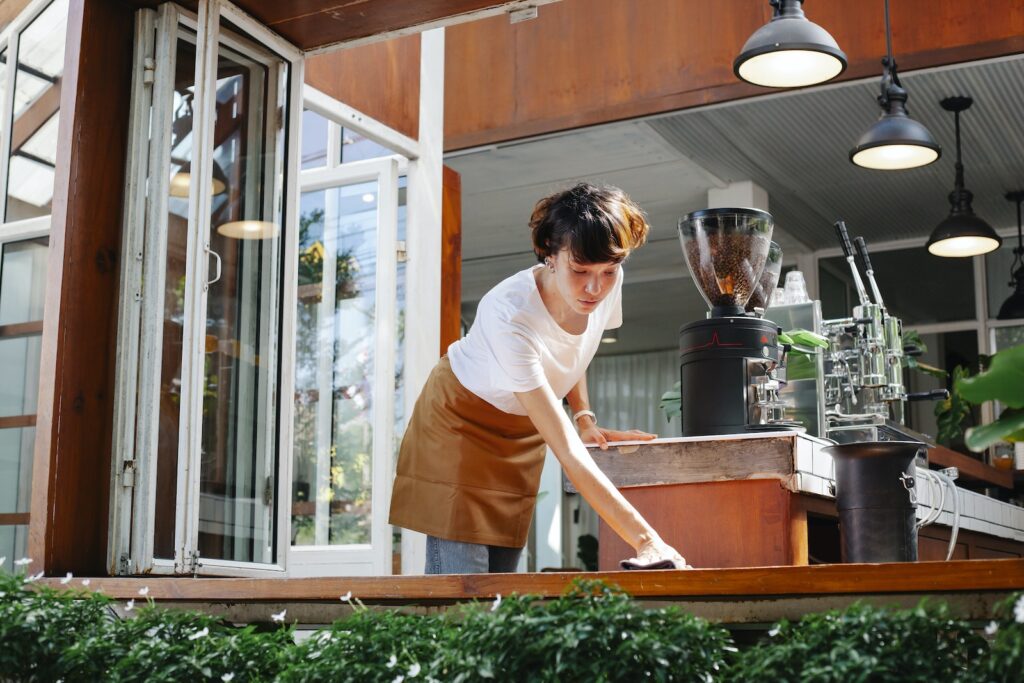Green cleaning is an eco-friendly and sustainable approach to cleaning that focuses on using products and methods that have minimal impact on the environment and human health. The goal of green cleaning is to reduce the use of harsh chemicals, conserve resources, and promote healthier indoor air quality while effectively cleaning and maintaining a clean and safe living or working environment. Key principles of green cleaning include:
1. Using Environmentally Friendly Products: Green cleaning prioritizes the use of biodegradable and non-toxic cleaning products that are derived from natural, renewable resources. These products typically have lower levels of volatile organic compounds (VOCs) and do not contain harmful chemicals.
2. Minimizing Waste: It involves reducing packaging waste by choosing products with eco-friendly packaging and minimizing disposable cleaning supplies like paper towels and single-use wipes.
3. Energy and Resource Efficiency: Green cleaning practices aim to reduce energy consumption and water usage during cleaning tasks. This may involve using cold water for cleaning, efficient appliances, and low-flow or no-flow cleaning equipment.
4. Indoor Air Quality: Green cleaning focuses on improving indoor air quality by avoiding products that emit harmful fumes or allergens. It encourages proper ventilation during cleaning to reduce exposure to indoor pollutants.
5. Safety and Health: It prioritizes the safety of those performing the cleaning tasks by minimizing exposure to potentially hazardous chemicals. This is particularly important in households with children, pets, or individuals with sensitivities or allergies.
6. Sustainability: Green cleaning considers the long-term environmental impact of cleaning practices and products, aiming to promote sustainability and reduce the carbon footprint associated with cleaning routines.
Overall, green cleaning is a holistic and responsible approach to cleaning that aligns with environmental stewardship and health-conscious living. It seeks to balance the need for cleanliness with a commitment to reducing the negative impacts of cleaning activities on the planet and its inhabitants.

Eco-Friendly Tips and DIY Cleaners:
Green cleaning is an eco-friendly approach to household cleaning that minimizes the use of harsh chemicals and reduces environmental impact. Here are some eco-friendly tips and DIY cleaners for green cleaning:
Eco-Friendly Cleaning Tips:
1. Use Natural Products: Opt for natural cleaning products that are biodegradable and free of harmful chemicals. Look for products labeled as “green,” “eco-friendly,” or “natural.”
2. DIY Cleaners: Create your own cleaning solutions using simple, non-toxic ingredients like baking soda, vinegar, lemon juice, and castile soap.
3. Reduce Packaging: Choose products with minimal or recyclable packaging to reduce waste.
4. Microfiber Cloths: Use microfiber cloths, which can effectively clean surfaces with just water, reducing the need for cleaning chemicals.
5. Recycle and Reuse: Reuse spray bottles and containers, and recycle old cleaning product containers properly.
6. Energy Efficiency: Use cold water for cleaning whenever possible to save energy.
7. Ventilation: Ensure proper ventilation when using cleaning products to prevent indoor air pollution.
DIY Eco-Friendly Cleaners:
1. All-Purpose Cleaner: Mix equal parts water and white vinegar in a spray bottle. Add a few drops of essential oil for a pleasant scent. This mixture can clean countertops, glass, and more.
2. Baking Soda Scrub: Baking soda is an excellent abrasive cleaner. Mix it with water to make a paste for scrubbing sinks, tubs, and stovetops.
3. Lemon Juice Deodorizer: Lemon juice can neutralize odors and disinfect. Use it to clean cutting boards and eliminate kitchen smells.
4. Olive Oil and Vinegar Wood Polish: Combine one part olive oil with one part vinegar and use it to polish and clean wood surfaces.
5. Homemade Carpet Freshener: Mix baking soda with a few drops of essential oil. Sprinkle it on carpets, let it sit for a while, then vacuum to freshen your carpets naturally.
6. Natural Toilet Bowl Cleaner: Sprinkle baking soda in the toilet bowl, add a bit of vinegar, and scrub with a toilet brush to clean and deodorize.
7. Window Cleaner: Mix water with a small amount of dish soap in a spray bottle for streak-free window cleaning. Green cleaning not only reduces the environmental impact of your cleaning routine but also minimizes exposure to harmful chemicals for you and your family. It’s a healthier and more sustainable way to keep your home clean.

How Green Cleaning Contributes to Home Cleaning?
Green cleaning contributes to home cleaning by providing a more environmentally friendly and health-conscious approach to keeping your living space clean. Here’s how green cleaning benefits home cleaning:
1. Reduced Chemical Exposure: Green cleaning minimizes exposure to harsh and potentially harmful chemicals found in many conventional cleaning products. This is especially important for households with children, pets, or individuals with sensitivities or allergies.
2. Improved Indoor Air Quality: By avoiding products that emit harmful fumes and promoting proper ventilation during cleaning, green cleaning helps maintain healthier indoor air quality. This contributes to a more comfortable and breathable living environment.
3. Safer for Surfaces: Many green cleaning solutions are gentle and safe for a wide range of surfaces, including hardwood floors, countertops, and appliances. They can effectively clean without causing damage or discoloration.
4. Sustainable Practices: Green cleaning encourages the use of biodegradable and eco-friendly cleaning products, reducing the environmental impact of cleaning routines. It also promotes resource efficiency and waste reduction.
5. Healthier Living Environment: The use of natural cleaning ingredients like vinegar, baking soda, and lemon juice can effectively clean and disinfect surfaces while posing minimal health risks. This contributes to a healthier and safer home.
6. Reduced Allergen Exposure: Green cleaning methods can effectively remove allergens like dust, pollen, and pet dander, which is especially important for individuals with allergies or respiratory conditions.
7. Sustainability: Green cleaning aligns with sustainable living principles by minimizing waste, conserving resources, and reducing the carbon footprint associated with cleaning practices. It promotes eco-friendly choices in cleaning products and tools.
8. Cost-Effective: Many green cleaning solutions are affordable and can often be made from common household items, reducing the need to purchase expensive cleaning products.
9. Environmental Responsibility: By choosing green cleaning practices, homeowners can contribute to environmental conservation and support companies that prioritize sustainability in their cleaning product offerings.
In summary, green cleaning not only effectively cleans and maintains a home but does so while minimizing the negative impact on human health and the environment. It offers a holistic and responsible approach to home cleaning that promotes both cleanliness and well-being.
